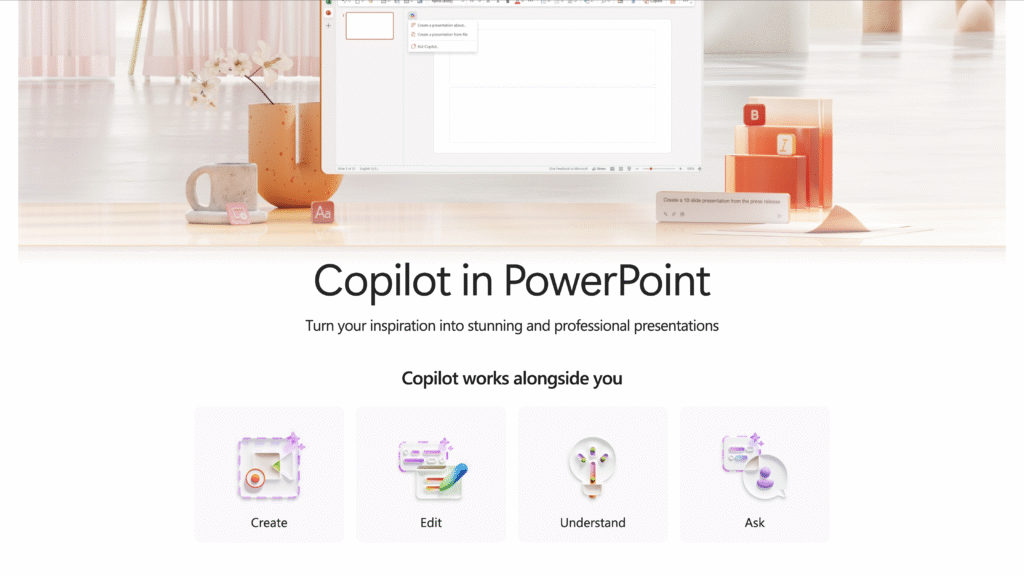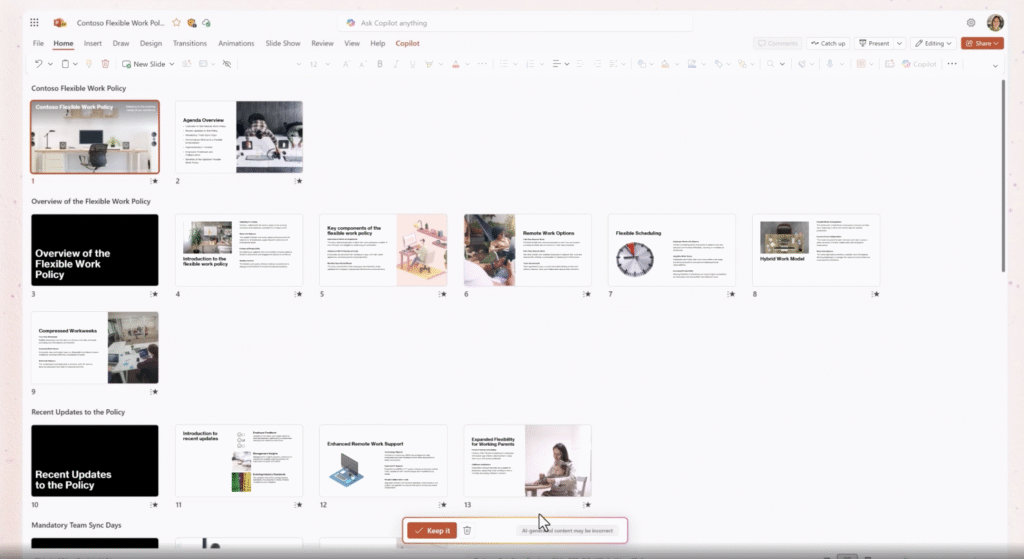
The Setup: When PowerPoint Meets Its Match

Picture this: it’s midweek morning, somewhere between the third espresso and the fourth Teams call. Our protagonist stands before a sleek presentation, wrestling with that most dreadful of corporate clichés—”catalyst”. The word hangs in the air like a poorly chosen font. Enter Microsoft 365 Copilot Chat, stage right, with all the confidence of a well-rehearsed understudy.
“Too formal,” it whispers. “How about ‘drives business’?”
And just like that, corporate jargon gets its marching orders.
The thirty-second spot that follows is a masterclass in Microsoft’s marketing machinery—polished, purposeful, and packed with just enough multilingual flourish to remind us that business is indeed global. Yet beneath its glossy veneer lies a question that should keep digital marketers awake at night: when did efficiency become more valuable than authenticity?
Act I: The Seductive Promise of Algorithmic Eloquence

Technical Wizardry Meets Corporate Reality
Copilot Chat’s proposition is undeniably clever. Built on Large Language Models that can pivot from boardroom gravitas to Friday afternoon casualness, it promises to solve that age-old marketing conundrum: how to speak to everyone without boring anyone.
The technical architecture is sound—natural language processing algorithms trained on vast datasets, integrated seamlessly into Microsoft’s existing ecosystem, with minimal IT headaches for deployment. For global teams juggling cultural nuances and time zones, it’s rather like having a diplomatic interpreter who never needs coffee.
The appeal is obvious: why labour over tone when an algorithm can do the heavy lifting?
This connects to the broader challenges I explored in my analysis of The Testimonial Tango: OpenAI’s Dance Between Authenticity and Algorithm, where corporate communications increasingly rely on AI-generated perfection at the expense of genuine human connection.
A Global Stage Beckons
The cameo Spanish coaching—”Que nunca se detenga”—isn’t mere window dressing. It signals Microsoft’s understanding that modern marketing operates across linguistic boundaries. For digital marketers building campaigns from Bengaluru to Barcelona, this multilingual dexterity represents genuine value.
Consider the harried agency creative, pivoting between a pharmaceutical client’s sober messaging and a fintech startup’s irreverent tone. Copilot Chat promises to be the chameleon in their toolkit, adapting voice and register with algorithmic precision. As someone who’s helped brands navigate these exact challenges through strategic planning and messaging, I can appreciate the appeal—even whilst questioning the execution.
Act II: The Uncomfortable Truth About Perfect Prose
When Flawless Becomes Suspicious

Here’s where the plot thickens—and where Microsoft’s advertisement reveals its blind spot. Research consistently shows that colleagues harbour suspicion towards overly polished communications. When prose feels too refined, trust actually erodes rather than builds.pmc.ncbi.nlm.nih
It’s the linguistic equivalent of the uncanny valley—that peculiar phenomenon where something appears almost human but triggers unease rather than comfort. Employees can sense when their manager’s latest memo has been through the algorithmic wash, and they respond accordingly.
The paradox is delicious: in pursuit of perfect communication, we risk losing the very humanity that makes communication worthwhile.
This mirrors patterns I’ve observed across my 16+ years in digital marketing, from my time crafting internal communications at Microsoft to helping brands find their authentic voice through content strategy.
The Trust Tax

A Harvard Business School study found that when employees suspected their CEO’s communications were AI-authored, they rated those messages as significantly less helpful—even when the content was identical. The implications for digital marketers are stark: credibility isn’t just about what you say, but about the perception of who’s saying it.library.hbs+1
This connects directly to observations I made in The Authenticity Game: Google’s Pixel 10 and the Fine Art of Honest Dishonesty, where even tech giants struggle with balancing algorithmic efficiency against human authenticity.
Act III: Marketing Lessons From Microsoft’s Miscalculation
The Audience Misalignment Problem
The advertisement targets efficiency-seekers but ignores authenticity-demanders. It’s a classic case of solving yesterday’s problem while tomorrow’s challenge goes unaddressed. Modern professionals don’t simply want better-written emails—they want communications that feel genuinely authored by the people they know and trust.
During my tenure at Microsoft, I witnessed firsthand how internal communications that felt too polished often generated less engagement than those with a more human touch. The most successful campaigns were those that acknowledged their algorithmic assistance whilst maintaining clear human authorship.
Strategic Recommendations for Digital Marketers

1. Embrace Transparent AI Partnership
Rather than hiding algorithmic assistance, showcase the collaboration. Position AI as your research assistant, not your ghostwriter. A simple disclosure—”Refined with AI, perfected by humans”—can transform suspicion into curiosity. This approach aligns with my philosophy of building authentic brand voices that acknowledge their tools whilst maintaining their personality.
2. Celebrate the Iterative Process
Show the messy first draft alongside the polished version. Audiences appreciate authenticity more than perfection. Consider creating content that reveals your creative process, complete with false starts and algorithmic suggestions. This mirrors the approach I took when scaling LinkedIn presence from 2K to 20K followers—showing the work, not just the results.
3. Maintain Cultural Specificity
Use AI for linguistic accuracy and tone consistency, but preserve local flavour and cultural references that algorithms might miss. The client in Delhi doesn’t want the same voice as the client in Düsseldorf. My experience working across diverse markets, from academic publishing at Cambridge University Press to AI-first InsurTech at Monocept, has taught me that authenticity is always local, even when reach is global.
4. Technical Integration Without Soul Replacement
Deploy Copilot’s capabilities for grammar, multilingual support, and consistency checks. But reserve the voice, personality, and strategic messaging decisions for human judgment. This is precisely the balance I strike in my UX and microcopy work—letting technology handle the mechanics whilst humans handle the magic.
Act IV: The Technical Deep Dive

Under Copilot’s Hood
Microsoft’s implementation leverages transformer-based models trained on diverse communication datasets. The tone adjustment feature uses natural language understanding to identify register markers—formality indicators, cultural context cues, and audience-appropriate vocabulary selections.
The multilingual capability operates through cross-lingual embeddings that preserve meaning while adapting cultural communication patterns. For technical marketers, this represents a significant advancement in AI-assisted content creation, particularly for global campaigns requiring cultural sensitivity.
Yet therein lies the rub: technical sophistication doesn’t automatically translate to emotional resonance.
Drawing from my experience in academic publishing, where precision and clarity are paramount, I’ve learned that the most effective communication tools are those that improve human capability rather than replace human judgment.
Performance Metrics That Matter
Traditional metrics—click rates, engagement scores, conversion percentages—may not capture the subtler impact on brand trust and long-term relationship building. Digital marketers using AI assistance need to develop new measurement frameworks that account for authenticity perception alongside efficiency gains.
This is where my approach to email campaigns and newsletters proves valuable—I’ve consistently achieved 70-90% click-to-open rates by prioritising genuine connection over algorithmic optimisation.
Act V: The Path Forward
Repositioning the Narrative
Had I been crafting Microsoft’s campaign, I’d have positioned Copilot Chat as a collaborative partner rather than a replacement writer. Show the human struggle, the algorithmic assistance, and the final human approval—a trinity of authentic creation.
Picture this alternative: a marketer sketching ideas on a coffee-stained napkin, inputting rough thoughts into Copilot, reviewing the suggestions with a wry smile (“Really, Copilot? ‘Synergistic solutions’?”), and crafting the final version with their own voice intact.
This approach mirrors the methodology I’ve developed through years of brand strategy and content development—tools assist, humans decide, authenticity prevails.
The Authenticity Audit
For digital marketing teams adopting AI writing tools, I recommend establishing an “authenticity audit” process:
- Does this sound like something our brand would genuinely say?
- Would our audience recognise our voice if we stripped away the perfect grammar?
- Are we using AI to enhance our message or replace our personality?
These questions form part of my strategic planning process when working with brands to develop their communication frameworks.
Conclusion: Efficiency Versus Soul

Microsoft’s Copilot Chat represents remarkable technical achievement wrapped in questionable marketing messaging. The tool itself has genuine value—particularly for global teams navigating linguistic complexity and cultural nuance. But the advertisement’s celebration of algorithmic perfection misses the deeper cultural moment we’re experiencing.
In an era of increasing digital scepticism, authenticity has become the ultimate premium product.
For digital marketers, the lesson isn’t to avoid AI assistance—it’s to use it thoughtfully, transparently, and always in service of genuine human connection. Let Copilot handle the grammar and suggest the synonyms, but keep the voice, the quirks, and the humanity firmly in human hands.
After all, in our rush toward algorithmic eloquence, we mustn’t forget that the most memorable communications aren’t the most perfect ones—they’re the most human ones. This philosophy has guided my work across every role and every service I offer—from corporate giants to nimble startups, the brands that win are those that remember their humanity.
Looking to balance AI efficiency with authentic brand voice? I’d love to help you navigate this challenge through thoughtful strategy and human-centred content. Drop me a line—let’s chat about making technology work for your brand, not the other way around.
Sources:
- https://pmc.ncbi.nlm.nih.gov/articles/PMC10135857/
- https://www.library.hbs.edu/working-knowledge/ai-can-help-leaders-communicate-but-cant-make-employees-listen
- https://www.thehrdigest.com/managers-beware-ai-written-emails-might-erode-employee-trust/
- https://ppl-ai-file-upload.s3.amazonaws.com/web/direct-files/attachments/10660488/358a21a2-bda9-4ab3-83e2-13ff64d38d7b/Microsoft-s-Copilot-Chat-Advertisement_-A-Marketin.docx
- https://suchetanabauri.com
- https://suchetanabauri.com/blogs/
- https://suchetanabauri.com/services/
- https://suchetanabauri.com/about/
- https://suchetanabauri.com/testimonial-tango-openai-gpt5-corporate-marketing-analysis/
- https://suchetanabauri.com/google-pixel-10-ai-marketing-authenticity-analysis/
- https://suchetanabauri.com/the-shaking-frame-apples-accessibility-advertising-between-sincerity-and-spectacle/
- https://suchetanabauri.com/manufactured-spectacle-google-pixel-2025-launch-analysis/
- https://suchetanabauri.com/pixel-paradox-google-marketing-reality-digital-native/
- https://suchetanabauri.com/federer-dravid-uniqlo-campaign-india-digital/
- https://suchetanabauri.com/
